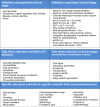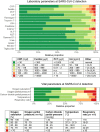First results of the "Lean European Open Survey on SARS-CoV-2-Infected Patients (LEOSS)"
- PMID: 33001409
- PMCID: PMC7527665
- DOI: 10.1007/s15010-020-01499-0
First results of the "Lean European Open Survey on SARS-CoV-2-Infected Patients (LEOSS)"
Abstract
Purpose: Knowledge regarding patients' clinical condition at severe acute respiratory syndrome coronavirus 2 (SARS-CoV-2) detection is sparse. Data in the international, multicenter Lean European Open Survey on SARS-CoV-2-Infected Patients (LEOSS) cohort study may enhance the understanding of COVID-19.
Methods: Sociodemographic and clinical characteristics of SARS-CoV-2-infected patients, enrolled in the LEOSS cohort study between March 16, 2020, and May 14, 2020, were analyzed. Associations between baseline characteristics and clinical stages at diagnosis (uncomplicated vs. complicated) were assessed using logistic regression models.
Results: We included 2155 patients, 59.7% (1,287/2,155) were male; the most common age category was 66-85 years (39.6%; 500/2,155). The primary COVID-19 diagnosis was made in 35.0% (755/2,155) during complicated clinical stages. A significant univariate association between age; sex; body mass index; smoking; diabetes; cardiovascular, pulmonary, neurological, and kidney diseases; ACE inhibitor therapy; statin intake and an increased risk for complicated clinical stages of COVID-19 at diagnosis was found. Multivariable analysis revealed that advanced age [46-65 years: adjusted odds ratio (aOR): 1.73, 95% CI 1.25-2.42, p = 0.001; 66-85 years: aOR 1.93, 95% CI 1.36-2.74, p < 0.001; > 85 years: aOR 2.38, 95% CI 1.49-3.81, p < 0.001 vs. individuals aged 26-45 years], male sex (aOR 1.23, 95% CI 1.01-1.50, p = 0.040), cardiovascular disease (aOR 1.37, 95% CI 1.09-1.72, p = 0.007), and diabetes (aOR 1.33, 95% CI 1.04-1.69, p = 0.023) were associated with complicated stages of COVID-19 at diagnosis.
Conclusion: The LEOSS cohort identified age, cardiovascular disease, diabetes and male sex as risk factors for complicated disease stages at SARS-CoV-2 diagnosis, thus confirming previous data. Further data regarding outcomes of the natural course of COVID-19 and the influence of treatment are required.
Keywords: COVID-19; Cohort study; LEOSS; SARS-CoV-2.
Conflict of interest statement
On behalf of all authors, the corresponding author states that there is no conflict of interest.
Figures



References
-
- World Health Organization. Coronavirus disease (COVID-19) outbreak situation. 2020. https://covid19.who.int/. Accessed 25 May 2020.
Publication types
MeSH terms
Substances
LinkOut - more resources
Full Text Sources
Medical
Miscellaneous

